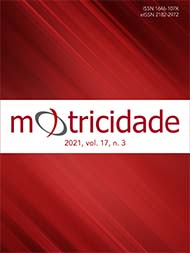Reliability of the handheld dynamometer in the evaluation of the muscle strength of trunk extensors in healthy adults
DOI:
https://doi.org/10.6063/motricidade.20784Keywords:
Manual Dynamometer, Assessment, Force, Back Strength, Evidence-Based PracticeAbstract
The muscular performance of the lumbar spine is frequently assessed in studies that compare populations with and without low back pain. However, the gold standard equipment used to evaluate the strength of these muscles has a high cost. Therefore, rarely used in the clinical practice of health professionals, being the handheld dynamometer is an accessible alternative for use in clinical practice. Therefore, this study aimed to determine the reliability of the handheld dynamometer in the measurement of maximum voluntary isometric contraction of trunk extensors in healthy adults. Twenty-six healthy adults of both sexes (21.53± 1.88 years old) performed the test and retest with a 1-week interval. The comparison between test-retest demonstrated high and very high intraclass correlation coefficient for peak strength (0.82; 0.60 to 0.92) and mean strength (0.90; 0.76 to 0.95), respectively. Also, the Bland-Altman analyses indicate an error of 5.10 kg for peak strength and 5.7 kg for mean strength. In addition, the minimum detectable change for peak strength was 6.03kg (16.18%) and 5.92 kg for mean strength (20.95%). In conclusion, the test presents high reliability for the extensor muscles of the trunk in healthy adults. Therefore, the use of the handheld dynamometer can be indicated for clinical practice.
Keywords: manual dynamometer; assessment; force; back strength; evidence-based practice.
Downloads
Published
Issue
Section
License
The authors of submitted manuscripts must transfer the full copyright to Journal Motricidade / Sílabas Didáticas Editions. Granting copyright permission allows the publication and dissemination of the article in printed or electronic formats, and copyrights start at the moment the manuscript is accepted for publication. It also allows Journal Motricidade to use and commercialise the article in terms of licensing, lending or selling its content to indexation/abstracts databases and other entities.
According to the terms of the Creative Commons licence, authors may reproduce a reasonable number of copies for personal or professional purposes, but without any economic gain. SHERPA/RoMEO allows authors to post a final digital copy (post-printing version) of the article on their websites or on their institutions' scientific repository.


